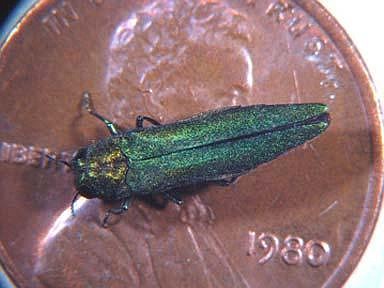A tree-killing pest is now in 75 counties in Missouri.
The Missouri Department of Conservation reports the presence of Emerald Ash Borer in 16 new counties across Missouri.
Four of those counties are in Mid-Missouri: Boone, Montgomery, Morgan and Osage.
EAB had earlier been found in Cole, Callaway, Miller and Maries counties. Moniteau is the only Mid-Missouri county not to have a report of EAB.
EAB is a small, metallic green beetle native to Asia that attacks all species of ash trees, including Missouri's native green ash and white ash, according to MDC officials. In its larval stage, the insect kills ash trees by feeding on the vascular tissues just under the bark, slowly cutting off the trees' flow of water and nutrients. EAB kills more than 99 percent of the ash trees it attacks.
It was first detected in Missouri in July 2008.
MDC Forest Entomologist Robbie Doerhoff in a news release urged Missourians with ash trees in their yard to make a plan now to either remove those trees or treat them with an insecticide, as EAB will likely be found statewide within the next few years.
Ash trees typically show a pattern of declining health for two to four years before being killed by EAB, Doerhoff said. Woodpecker damage, sprouts growing from the main trunk, and major branch loss can all suggest EAB is present.
"Trees with more than 30 percent crown damage often aren't good candidates for insecticide treatments, making it critical to start treatment on ash trees before they look bad," Doerhoff added. "Treatment should be done next spring or early summer. Also, make sure you know what insecticide you or your arborist is using. Not all insecticides are effective or recommended, and treatment options vary by tree size."
Find more information on recommended insecticides in MDC's EAB Management Guide for Missouri Homeowners at short.mdc.mo.gov/ZSq.
Ash trees that are removed should be disposed of locally to prevent the accidental spread of EAB to new locations, MDC officials said. EAB can emerge from ash firewood and logs for up to two years after harvest, so don't give EAB a free ride to your favorite camping locations.
"Emerald Ash Borer was likely introduced into Missouri by infested firewood," said Collin Wamsley, state entomologist for the Missouri Department of Agriculture. "Many other invasive forest pests such as the Asian longhorned beetle or gypsy moth are capable of hitchhiking long distances on firewood, and in turn, causing harm to Missouri's 15 million acres of forestland. Whether you heat your home with firewood or like to go camping, we recommend not moving firewood farther than 50 miles from where it was cut down."
MDC is encouraging Missourians to report possible EAB infestations in counties where the pest has not yet been confirmed. Reports can be made by using the form at eab.missouri.edu or by calling MDC's Forest Pest Hotline at 866-716-9974.

